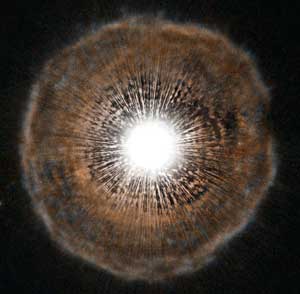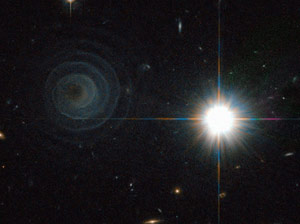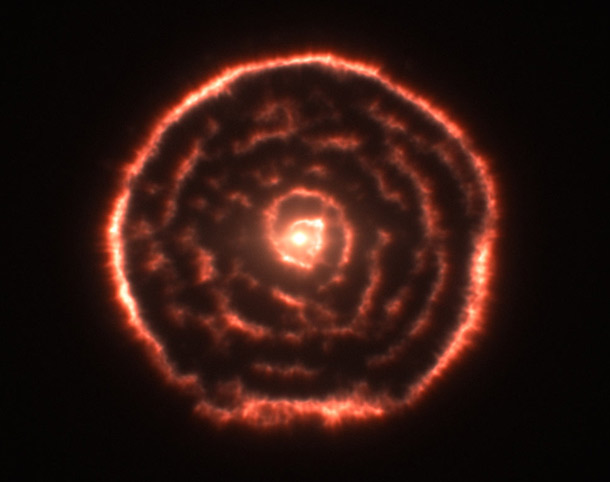Create a free profile to get unlimited access to exclusive videos, sweepstakes, and more!
A dying star weaves a spiral in the night

The number of ways stars can find to die bizarre deaths will never cease to amaze me.
Some explode, supernovae which blast radiation across the Universe. Others fade away slowly over hundreds of billions of years, longer than the cosmos has been around. Some blow off winds of gas and dust, taking on strange shapes from perfect spherical shells to elongated structures that look like two jellyfish kissing.
And then some - a very few - are like R Sculptoris, a red giant on the thin hairy edge of death. And its death is both spectacular as well as just plain old damned weird.
Check THIS out:
This is not a drawing! It's actual data, observations of R Sculptoris made using the Atacama Large Millimeter/submillimeter Array (ALMA). ALMA looks at light far too low energy for our eyes to see; it's actually out past infrared in the spectrum. Cold dust and gas emits light at this wavelength, including carbon monoxide. That molecule is created copiously in red giants and shines brightly in the submillimeter, making it easy to see with 'scopes like ALMA. That's nice, because CO can be used as a tracer for other, harder to detect molecules like hydrogen. Looking at CO really tells you a lot about what's going on in the gas and dust.
And what's going on? Ah, this is the really cool part.
When a star like the Sun (either a bit less massive, or up to about 8 times as massive) ages, the core heats up, which causes the outer part of the star to expand (like a hot air balloon), turning it into a red giant. The details are complicated - read this post on a similar star where I explain it in more detail (and you want to because the details are awesome) - but the bottom line is that helium builds up in a thin shell outside the star's core, where it fuses into carbon. The fusion rate is insanely sensitive to temperature, and periodic imbalances in temperature cause vast and very sudden increases in the fusion rate - and by sudden I mean over a timescale of just a handful of years, the blink of an eye to a star. Called a thermal pulse, this huge fireball of energy is dumped into the star's interior, blows upward like a tsunami, and then blasts material clear off the star's surface.
 The result is an epic paroxysm which blows out a massive wave of material, expanding in a sphere around the star. We've seen this before, like in the star U Cam. After a few years, you get an eerie detached shell of expanding material, like a smoke ring trillions of kilometers across.
The result is an epic paroxysm which blows out a massive wave of material, expanding in a sphere around the star. We've seen this before, like in the star U Cam. After a few years, you get an eerie detached shell of expanding material, like a smoke ring trillions of kilometers across.
OK, so that's the thin shell thing on the outside. So what's the deal with R Sculptoris that makes that freaky inner spiral pattern?
I'm glad you asked! Unlike U Cam, R Sculptoris has a companion. It's probably a smaller star, like a red dwarf or even something more like the Sun. It orbits the red giant once every 350 years, or, to be more accurate, the two stars orbit each other. As material from the red giant expands outward, the combined spin as the two stars' dance forms the spiral pattern.
It's like a rotating garden sprinkler. Each drop of water from the sprinkler goes straight outward, but each at a slightly different angle - like one drop heading due north, the next slightly east of north, the next slightly east of that, and so on around the compass points. To our eye, this looks like an expanding spiral, even though it's made of individual drops moving radially out from the center. It's an illusion of sorts.
This video might help. It was made using the ALMA observations, and shows the star starting about 250 years before the pulse. We see material expanding, then at t=0 there is the big pulse, forming the shell and spiral:
[If the video doesn't load, refresh this page, or try this link.]
Amazingly, we've seen this sort of thing before too. LL Peg has a spiral of material around it, formed in much this way. Interesting: U Cam has the shell with no spiral, and LL Peg has a spiral with no shell. R Sculptoris is more awesomer than them, because it has both.
 R Sculptoris has both a shell and a spiral because the thermal pulse had a very sudden, sharp beginning, but continued to drive material off the star's surface for many years after that first wave. That initial blast expanded rapidly, so rapidly compared to the orbital period of the second star that it was essentially instantaneous. In other words, there wasn't time to imprint the spiral pattern on it; it expanded outward in a spherical wave. It eventually collided with material previously ejected by the star, got compressed it, and formed the the thin shell. But back at the star the pulse continued, blowing off more material over time. That was slow enough that the orbital motion of the two stars affected the expansion, creating the spiral pattern.
R Sculptoris has both a shell and a spiral because the thermal pulse had a very sudden, sharp beginning, but continued to drive material off the star's surface for many years after that first wave. That initial blast expanded rapidly, so rapidly compared to the orbital period of the second star that it was essentially instantaneous. In other words, there wasn't time to imprint the spiral pattern on it; it expanded outward in a spherical wave. It eventually collided with material previously ejected by the star, got compressed it, and formed the the thin shell. But back at the star the pulse continued, blowing off more material over time. That was slow enough that the orbital motion of the two stars affected the expansion, creating the spiral pattern.
Amazing. But there's more!
Using the ALMA observations combined with models of the star's behavior, the scientists have found that this last pulse occurred 1800 years ago and lasted for 200 years. They were also able to estimate the amount of material blown away from the star: about 0.3% of the mass of the Sun.
Doesn't sound like much, does it? Well, let me rephrase that for you: the mass ejected by this star in this two-century long event was a thousand times the mass of the Earth. Oh, and did I mention that all this material was blasted outward at 50,000 kilometers per hour?
The energy it took to eject this much material at this speed is very roughly the same amount of energy the Sun puts out over the same time period. So that thermal pulse added as much energy to R Sculptoris as our entire Sun emits. That's actually rather terrifying.
But also very, very cool. Like I said way back at the beginning, it's truly astonishing how many ways stars find to die. In that way they're like people: some live their lives brightly and fast, blowing out in spectacular fashion, while others live dimly and just fade away. But others live normal lives, going about their everyday business, but when the day finally comes, they find the wherewithal to go out in truly amazing and heroic fashion.
Wait. Was I talking about stars or people?
Image credit: ALMA (ESO/NAOJ/NRAO); Video credit: Nature/M. Maercker et al./S. Mohamed/L. Calçada
Related Posts:
- Awesome death spiral of a bizarre star (and trust me, you really want to click on that link)
- The ghost in the shell
- Similar by eye, not by nature
- Awesomely bizarre light show freaks out Norway (and a followup)



























